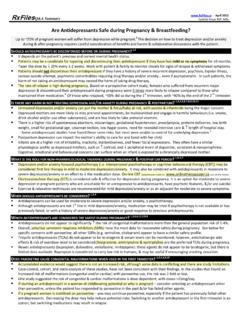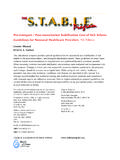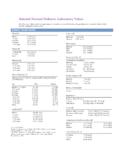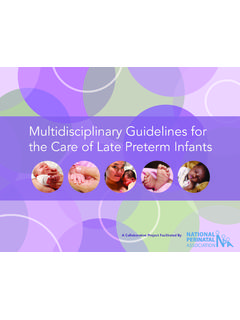Transcription of Prediction of neonatal hypoglycemia using cord …
1 Indian Journal of Basic and Applied Medical Research; March 2015: , Issue- 2, P. 167-171 167 P ISSN: 2250-284X , E ISSN : 2250-2858 Original article: Prediction of neonatal hypoglycemia using cord blood C-peptide and cord HbA1c in infant Of diabetic mother Mahapatra* , Raj** Department of OBGY* and Pediatrics** Name of the Institute/college: HI Tech Medical College , Bhubaneshwar , India Corresponding author : Mahapatra Abstract: Introduction: : Our aim was to find out the role of cord blood C-peptide and cord blood HbA1c in Prediction of neonatal hypoglycemia in infant of diabetic mother.
2 Methodology: A Prospective Observational Study. All the mothers with diabetes mellitus and their newly born delivered in HI-TECH MEDICAL COLLEGE,BBSR in a period of 1 year from September 2013 to September 2014 were recruited for the study after prior consent . Newborn with following complication were 2. IUGR baby Sepsis 4. Birth Asphyxia 5. RDS 6. MAS 7. Babies with major congenital anamolies. 2ml of cord blood was collected in EDTA vial for Hba1c estimation and another 2ml of cord blood was collected in plain vial for estimation of cord blood c-peptide.
3 As per protocol glucose monitoring was done in infant of diabetic mother to rule out hypoglycemia and fetal adverse outcome. As per American Academy of Pediatrics , neonatal hypoglycemia is defined as follows : Less than 40 mg/dl ( ) during first 24 hrs of life. Less than 50mg/dl ( mmol/l) after 24 hours of age. Results: Umbilical Cord HbA1c is a good predictor of neonatal hypoglycemia . The hypoglycemia in Infant of Diabetic mother was associated with raised cord blood c-peptide. Keywords: neonatal hypoglycemia ,IDM, cord blood c-peptide,cord blood Hba1c.
4 Introduction: In this modern era, obesity in childhood and in woman of child bearing age is one of the significant health burden . According to WHO, this health care problem is on the rise in both developed and developing nation .A sedentary life style, western diet and excessive food consumption are the principle cause of such phenomenon . It is observed that perinatal morbidity and mortality has increased by leaps and bounds with pregnancies in obese and diabetic women.
5 Diabetic mother has increased co-morbidities during pregnancy for instance neonatal hypoglycemia , respiratory distress syndrome ,fetal macrosomia ,birth injuries and congenital anamolies in newborn and pre-eclampsia/hypertension to the mother . In diabetic mother if there is poor glycemic control it will give rise to fetal hyperglycemia which in turn results in hyperplasia of islets of langerhans ,increased peripheral insulin receptors, a decreased glucagon response to hypoglycemia and delayed evocation of hepatic gluconeogenic pathway (1).
6 At delivery the transplacental supply of glucose is stopped and hypoglycemia in neonates occurs .Poor maternal glycemic control during the third trimester has been shown to be strongly and independently Indian Journal of Basic and Applied Medical Research; March 2015: , Issue- 2, P. 167-171 168 P ISSN: 2250-284X , E ISSN : 2250-2858 correlated with neonatal hypoglycemia requiring intervention. Glucose is an essential primary substrate for the substrate for the brain and its consumption by the brain cells is high.
7 Because of this, neurons and glial cells are susceptible to hypoglycemia . The vulnerable areas are the parieto-occipital regions of the cerebral cortex. Less commonly involved are neurons of hippocampus , caudate nucleus and putamen . Glial injury may give rise to subsequent disturbances in myelination (1). It has been seen that unrecognized postnatal hypoglycemia may lead to neonatal seizure. Fortunately, in most of these neonates ,hypog-lycemia is transient and asymptomatic.
8 However , if the diagnosis is missed and neonates fails to achieve normoglycemia ,it may become symptomatic and suffer long term complications of cerebral injury (3). So,it is useful to predict neonatal hypoglycemia from the state of neonatal hypoglycemic control. Human c-peptide is a 31 amino acid chain and is secreated from beta cells of pancreas in equimolar ratio with insulin . Cord serum c-peptide levels are used as an index of fetal beta cell function rather than insulin levels , because degradation of insulin is increased in presences of slight hemolysis (5).
9 Metzer BE et al (6) also found that frequency of neonatal hypoglycemia was higher with higher cord c-peptide levels and newborns with hypoglycemia tends to have higher frequency of cord c-peptide level of more than 90th percentile. In this way , c-peptide levels provide direct indication of endogenous fetal levels of insulin and could predict neonatal hypoglycemia in early neonatal life. Patients and methods: All the mothers with diabetes mellitus and their neonates delivered in HMCH, Bhubaneshwar in a period of 1 year from September 2013 to September 2014 were recruited for the study after prior consent.
10 INCLUSION CRITERIA: A total 50 neonates born to diabetic mothers during sept 2013 to sept 2014 were studied. EXCLUSION CRITERIA: Pre-term Babies, Babies with IUGR, neonatal complications namely sepsis or birth asphyxia, MAS( Meconium aspiration syndrome), respiratory distress syndrome, Babies with congenital anamolies. Neonates were screened for blood glucose at 4,6,8,12,18,24 hours of postnatal age . Out of 50 Neonates , 30 infants developed hypoglycemia at any time during the first 24 hrs of age.
















